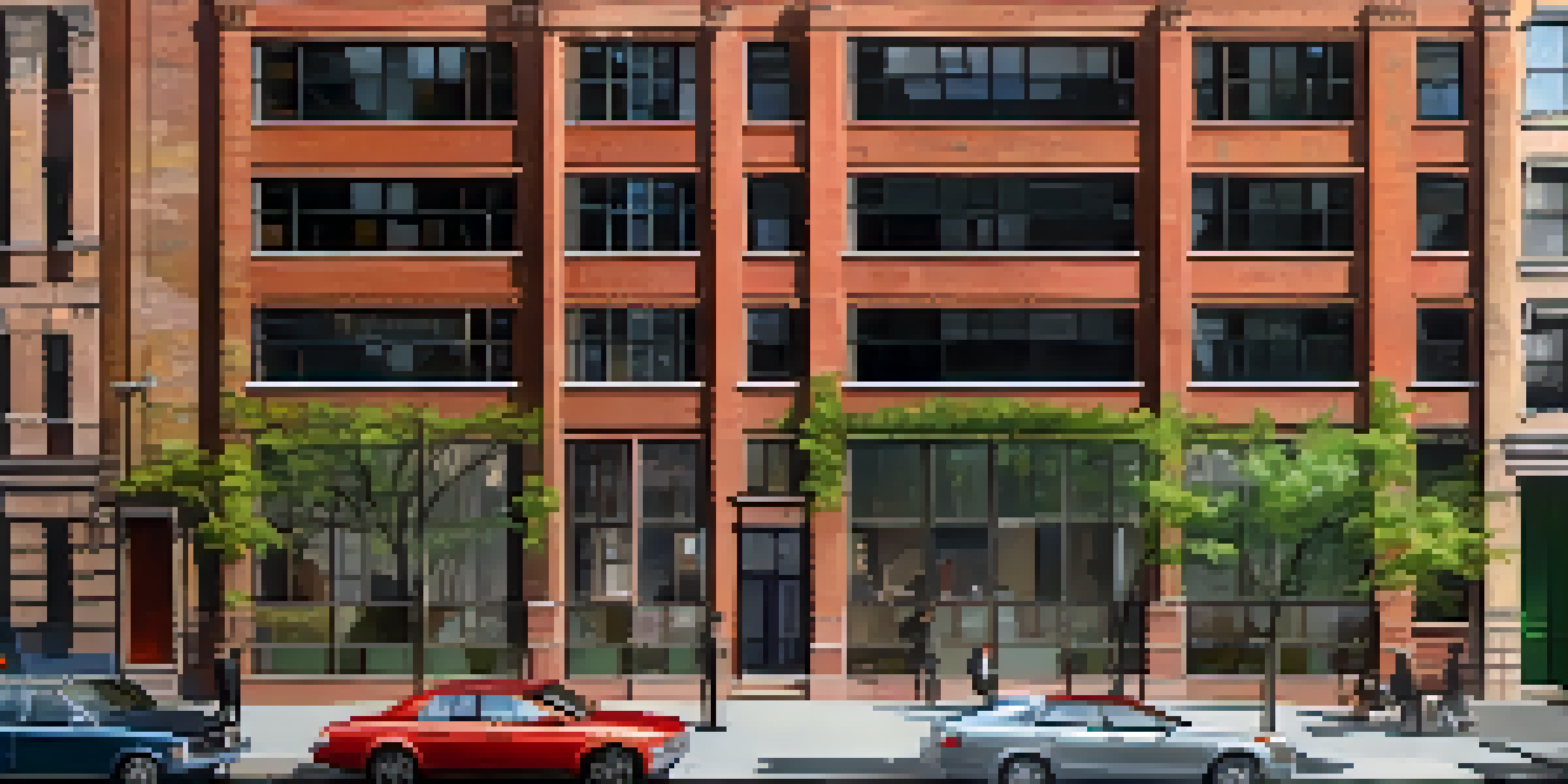Innovative Housing Solutions to Combat NYC's Affordability Crisis

Understanding NYC's Housing Affordability Challenge
New York City has long been known for its vibrant culture and bustling streets, but it’s also infamous for its soaring housing costs. With a population of over 8 million people, the demand for affordable housing continues to outpace supply, leading to a crisis that affects many residents. The struggle to find decent housing at a reasonable price has become an everyday reality for numerous New Yorkers, particularly those with lower incomes.
Affordable housing is not a privilege; it is a fundamental right for all citizens.
Factors contributing to this affordability crisis include rising property prices, stagnant wages, and a growing population. Many families are forced to spend a significant portion of their income on housing, often sacrificing other essential needs like healthcare or education. This situation not only affects individual households but also has broader implications for the city’s economy and social fabric.
As the city grapples with these challenges, innovative housing solutions are emerging as a beacon of hope. These solutions aim to create not just more affordable units, but also sustainable and inclusive communities where residents can thrive.
Micro-Housing: A Compact Solution for City Living
Micro-housing is gaining traction as an innovative approach to tackle New York City's housing crisis. By offering small, efficiently designed living spaces, micro-units allow residents to enjoy the benefits of city life without the exorbitant rent associated with larger apartments. These compact homes can be particularly appealing to students, young professionals, and those looking to downsize.

The concept of micro-housing is not just about reducing space; it's about maximizing functionality. Many designs include multifunctional furniture and shared community spaces, which fosters a sense of belonging among residents. This innovative housing model can help to alleviate the pressure on the city's housing market by increasing the number of available units in a relatively small footprint.
Innovative Housing Solutions Emerge
New York City is exploring creative housing solutions like micro-housing and co-living to address its affordability crisis.
Cities like New York have begun to embrace micro-housing developments, and the response has been overwhelmingly positive. As more people recognize the benefits of living in smaller, community-oriented environments, micro-housing could play a pivotal role in addressing the affordability crisis.
Co-Living Spaces: Fostering Community and Affordability
Co-living spaces are another innovative solution gaining popularity in urban areas, including New York City. These shared living arrangements allow individuals to rent private bedrooms within larger apartments or homes while sharing common areas like kitchens and lounges. This setup not only reduces housing costs but also encourages social interaction and community building among residents.
Housing is a human right, not a commodity to be bought and sold.
The co-living model appeals especially to millennials and Gen Z renters who value experiences and connections over traditional living arrangements. By creating a sense of shared purpose, co-living spaces can combat feelings of isolation and promote collaboration among residents, enhancing their overall quality of life. Additionally, these arrangements can help mitigate the burden of high rent prices by splitting costs among several people.
As more co-living companies emerge in NYC, they are reshaping the way people think about housing. By prioritizing community alongside affordability, co-living spaces could very well be a key part of the solution to the city's housing crisis.
Adaptive Reuse: Transforming Existing Structures
Adaptive reuse involves converting underutilized or abandoned buildings into affordable housing, and it's an approach gaining momentum in New York City. This method not only breathes new life into neglected structures but also preserves the city's rich architectural history. By repurposing existing buildings, cities can quickly increase their housing stock without the lengthy process of new construction.
For instance, old factories, warehouses, and even churches are being transformed into vibrant residential communities. These projects often incorporate modern amenities while maintaining the character of the original structure, attracting residents who appreciate both history and contemporary living. Additionally, adaptive reuse can be more sustainable, reducing waste and minimizing the environmental impact associated with new construction.
Community Engagement is Key
Involving residents in housing planning ensures solutions are relevant and beneficial to the community's needs.
As New York continues to explore innovative housing solutions, adaptive reuse presents a practical and creative way to address the affordability crisis while honoring the city’s heritage. By recognizing the potential of existing structures, the city can pave the way for more inclusive housing options.
Public-Private Partnerships: Collaborative Housing Initiatives
Public-private partnerships (PPPs) are emerging as a viable strategy to tackle NYC's housing affordability crisis. These collaborations between government entities and private developers can lead to the creation of more affordable housing units while ensuring that projects remain financially viable for all stakeholders. By pooling resources, expertise, and funding, both parties can work toward a common goal of increasing housing availability.
One successful example is the development of mixed-income housing projects, where a portion of the units are set aside for low-income residents while the rest are sold at market rates. This approach not only provides affordable options but also fosters diverse communities by integrating various income levels. The collaboration can also lead to innovative designs and efficient use of land, maximizing the impact of each project.
As NYC seeks effective solutions to its housing crisis, leveraging public-private partnerships could be a game changer. By harnessing the strengths of both sectors, the city can create sustainable, affordable housing that benefits everyone.
Technological Innovations: Smart Solutions for Housing
Technology is playing a crucial role in revolutionizing the housing landscape in New York City. From smart home automation to advanced construction techniques, these innovations are enhancing the way we build and live. For instance, modular construction allows for quicker assembly of housing units, reducing both time and costs while maintaining quality standards.
Additionally, technology can improve energy efficiency and sustainability in housing developments. Smart appliances and building management systems help reduce utility costs for residents, making homes not only more affordable but also environmentally friendly. With rising concerns about climate change, integrating technology in housing solutions is becoming increasingly important.
Zoning Reforms for More Housing
Revising zoning laws can create more opportunities for affordable housing development and efficient land use in NYC.
As NYC embraces these technological advancements, it opens up new possibilities for innovative housing solutions. By marrying modern technology with traditional housing needs, the city can create spaces that are not only affordable but also future-proof.
Zoning Reforms: Creating Space for Affordable Housing
Zoning reforms are essential to address NYC's housing affordability crisis effectively. By revisiting and modifying existing zoning laws, the city can create more opportunities for affordable housing development. This includes increasing density allowances, promoting mixed-use developments, and easing restrictions on building heights, which can lead to more efficient use of space.
For example, allowing developers to build taller buildings in certain neighborhoods can create more housing units while also providing commercial spaces that benefit the local economy. Zoning reforms can also encourage the conversion of underutilized lots into residential areas, maximizing the potential of available land. These changes not only provide more housing options but can also help revitalize struggling neighborhoods.

As NYC considers these zoning adjustments, it's important to ensure that the changes prioritize affordability and inclusivity. By making strategic reforms, the city can foster a more equitable housing landscape that meets the needs of all its residents.
Community Engagement: Involving Residents in Housing Solutions
Community engagement is a crucial element in developing effective housing solutions in New York City. By involving residents in the planning and decision-making processes, developers and city officials can better understand the needs and preferences of those who will inhabit these spaces. This collaborative approach not only builds trust but also ensures that housing solutions are tailored to the community's unique context.
Various initiatives, such as town hall meetings, workshops, and surveys, allow residents to voice their opinions and share their experiences. This feedback can guide the design and implementation of housing projects, making them more relevant and beneficial to the community. Moreover, when residents feel heard and valued, they are more likely to take ownership of their neighborhoods and contribute to their ongoing development.
By prioritizing community engagement in housing initiatives, NYC can create more inclusive and sustainable solutions. Ultimately, when residents play an active role in shaping their living environments, the result is a stronger, more connected community.